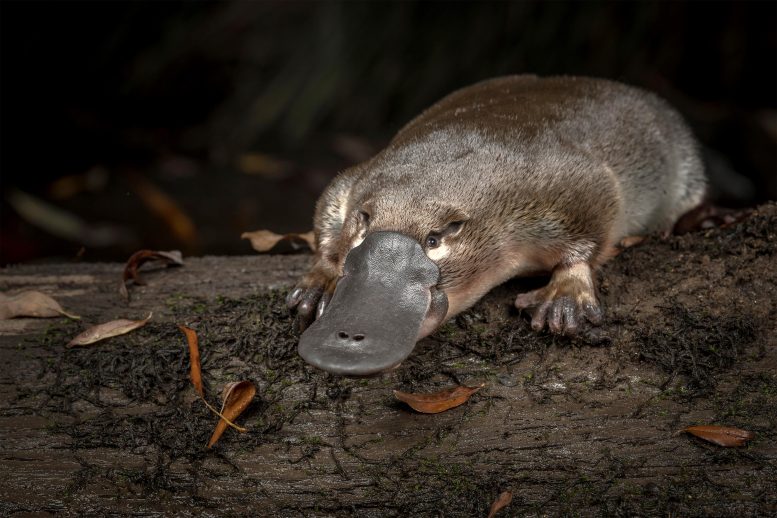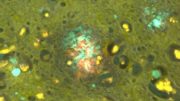
New methods have shown that platypus has ten sex chromosomes. Credit: © Doug Gimesy
Three papers unveil the extraordinary diversity of animal sex chromosomes.
The sex chromosomes genetically define the developmental fate of an embryo to become a male or a female individual, and usually appear as one pair of morphologically different chromosomes between sexes. For example, women have one pair of XX chromosomes, while men have one pair of XY chromosomes.
Now three studies led or co-led by Qi Zhou’s group at the University of Vienna and Zhejiang University of China uncovered the unusual sex chromosomes of Australian iconic animals platypus and emu, as well as Pekin duck. Platypus have five pairs of sex chromosomes forming an unusual chain shape, while the sex chromosomes of emu and duck are not as different between sexes as those of humans.
These works are the results of international collaboration between scientists from Austria, Australia, China, and Denmark, and are published as research papers together on Jan. 6th in the journals Nature, Genome Research, and GigaScience.
Sex chromosomes are presumed to originate from a pair of identical ancestral chromosomes by acquiring a male- or a female-determining gene on one chromosome. To prevent the sex-determining gene from appearing in the opposite sex, recombination is suppressed on sex chromosomes.
This leads to the degeneration of the Y chromosome (or the W chromosome in the case of birds) and the morphological difference of sex chromosomes between sexes. For example, the human Y chromosome bears only less than 50 genes, while the human X chromosome still maintains over 1500 genes from the autosomal ancestor. This process occurred independently in birds, in monotremes (the Australian platypus and echidnas), and in the other mammals (therians, e.g., kangaroo, mouse, human, etc.)
Platypus has ten sex chromosomes
With its venom, duck-bill, egg, and milk, platypus features an extraordinary combination of reptiles, birds, and mammals. Previous work showed that platypus, although undoubtedly a mammalian species, have sex chromosomes that do not share the same origin with those of humans. It turns out that the male platypus has five pairs of XY chromosomes (named as X1Y1, X2Y2, etc.), and none of them are homologous to the XY of human or mouse.
These ten sex chromosomes pair with each other in a head-to-tail manner and form a chain during meiosis when sperm cells develop. The genetic makeup and the evolution process of such a complex and unique sex chromosome system remained unclear, because the previously published platypus genome is was from a female, and only a quarter of the sequences is was mapped onto chromosomes.
Cutting-edge sequencing techniques
An international team of researchers adopted a new sequencing technique (called PacBio, or third-generation sequencing) that can “read” the genome information for over 300-fold longer in length than the last-generation technique, and the new chromatin conformation capture technique that can connect and map the genomic sequences into the chromosome level.
“With further laborious cytogenetic experiments, we improved the genome quality and mapped over 98% of the sequences into 21 autosomes, and 5X and 5Y chromosomes of platypus,” says Guojie Zhang from BGI-Shenzhen and University of Copenhagen. “The new genomes are a hugely valuable public resource for research in mammalian biology and evolution, with applications in wildlife conservation and even human health,” says Frank Grützner at University of Adelaide in Australia.
From a ring to a chain
“What surprised us is that, from the new sex chromosome sequences, we found the last Y chromosome, Y5 does not share many sequences with its pairing X5 chromosome, but with the first X chromosome of the chain, X1”, says Qi Zhou. “This suggested that the 10 platypus sex chromosomes used to be in a ring shape. Maybe the acquisition of a male-determining gene and suppression of recombination broke the ancestral chromosome ring into a chain.” This part of the sex chromosome work provides an entirely new perspective on the evolution of this extraordinary sex chromosome system, along with other new discoveries of platypus genes related to milk production, loss of teeth and so on, were published in Nature as a research article.
Different sex systems of birds and mammals
With similar new techniques used for the platypus genome, the Zhou group simultaneously decoded the sex chromosome sequences of emu and Pekin duck, which represent the different phase of sex chromosome evolution. Most mammalian and bird species’ sex chromosomes have evolved into their terminal stage of evolution like that of human or chicken. A key difference between mammals and birds is that instead of the XY sex system, birds have so-called ZW sex chromosomes. That is, male birds have a pair of ZZ chromosomes, female birds have a Z and a W sex chromosomes.
Slow-evolving sex chromosomes of emu and duck
The Y or W chromosomes usually have lost most functional genes, and become a “gene desert” full of repetitive sequences. Emu is an exception: its sex chromosomes are largely like a pair of autosomes, with over two-thirds of the sequences and active genes still shared between the Z and W chromosomes. “This may be related to the slower evolution rate of the emu compared to other birds”, says Jing Liu, a Ph.D. student in the Zhou group. “By comparing the genomes of emu and 11 other bird species, we found that large-bodied birds like emu and ostrich tend to have much fewer chromosome rearrangements than other birds.”
Another possible reason is that these flightless large birds may undergo much weaker sexual selection, a potential driver for sex chromosome evolution, compared to other birds, given that male and female emus are largely monomorphic. This provides a great system to understand how sex chromosomes evolve in their early phase – and in the case of Pekin duck, in the middle phase. Another project from the Zhou group generated the high-quality genome sequence of Pekin duck, a very popular poultry species. Emu, duck, and chicken together mark the different time phases of sex chromosome evolution.
In this work, we found that the W chromosomes of emu and duck have retained many more functional genes on their W chromosomes compared to the chicken. Such a large variation in the tempo of sex chromosome evolution is not observed in mammals, and reflects the different evolutionary modes of the XY and ZW sex systems. These novel sex chromosome sequences of emu and duck will also provide important resources for poultry studies.
References:
“Platypus and echidna genomes reveal mammalian biology and evolution” by Yang Zhou, Linda Shearwin-Whyatt, Jing Li, Zhenzhen Song, Takashi Hayakawa, David Stevens, Jane C. Fenelon, Emma Peel, Yuanyuan Cheng, Filip Pajpach, Natasha Bradley, Hikoyu Suzuki, Masato Nikaido, Joana Damas, Tasman Daish, Tahlia Perry, Zexian Zhu, Yuncong Geng, Arang Rhie, Ying Sims, Jonathan Wood, Bettina Haase, Jacquelyn Mountcastle, Olivier Fedrigo, Qiye Li, Huanming Yang, Jian Wang, Stephen D. Johnston, Adam M. Phillippy, Kerstin Howe, Erich D. Jarvis, Oliver A. Ryder, Henrik Kaessmann, Peter Donnelly, Jonas Korlach, Harris A. Lewin, Jennifer Graves, Katherine Belov, Marilyn B. Renfree, Frank Grutzner, Qi Zhou and Guojie Zhang, 6 January 2021, Nature.
DOI: 10.1038/s41586-020-03039-0
“A new emu genome illuminates the evolution of genome configuration and nuclear architecture of avian chromosomes” by Jing Liu, Zongji Wang, Jing Li, Luohao Xu, Jiaqi Liu, Shaohong Feng, Chunxue Guo, Shengchan Chen, Zhanjun Ren, Jinpeng Rao, Kai Wei, Yuezhou Chen, Erich Jarvis, Guojie Zhang and Qi Zhou, 6 January 2021, Genome Research.
DOI:
“A new duck genome reveals conserved and convergently evolved chromosome architectures of birds and mammals” by Jing Li, Jilin Zhang, Jing Liu, Yang Zhou, Cheng Cai, Luohao Xu, Xuelei Dai, Shaohong Feng, Chunxue Guo, Jinpeng Rao, Kai Wei, Erich D Jarvis, Yu Jiang, Zhengkui Zhou, Guojie Zhang and Qi Zhou, 6 January 2021, GigaScience.
DOI: 10.1093/gigascience/giaa142









Reminds me of chromosome pairing in evening primrose: “Due to reciprocal chromosomal translocations, many species of Oenothera (evening primrose) form permanent multichromosomal meiotic rings.” (http://www.plantcell.org/content/26/3/1280).